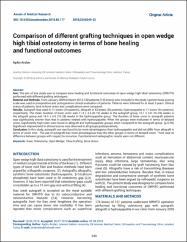Comparison of Different Grafting Techniques in Open Wedge High Tibial Osteotomy İn Terms of Bone Healing and Functional Outcomes
Özet
Aim: The aim of this study was to compare bone healing and functional outcomes of open wedge high tibial osteotomy (OWHTO) performed with different grafting techniques. Material and Methods: From January 2009 to March 2014, 132 patients (145 knees) were included in the study. Lysholm knee scoring scale was used in preoperative and postoperative clinical evaluation of patients. Patients were followed for at least 3 years. Clinical status of patients, time to bone union and complications were compared. Results: Autograft was used in 31 knees (29 patients), allograft in 43 knees (39 patients), hydroxyapatite in 71 knees (64 patients), respectively. The mean duration of bone union was 11.9 ± 3.6 (8-19) weeks in the autograft group, 13.1 ± 3.8 (10-25) weeks in the allograft group and 14.4 ± 4.9 (10-28) weeks in the hydroxyapatite group. The duration of bone union in autograft patients was significantly shorter than that in patients treated with hydroxyapatite. When the groups were evaluated in terms of delayed union, significantly high rates were found in allograft and hydroxyapatite groups when compared to the autograft group. (p<0.05) Significant improvement in clinical scores was observed in all groups postoperatively. Conclusion: In this study, autograft use was found to be more advantageous than hydroxyapatite and did not differ from allograft in terms of union time. The use of autograft was more advantageous than the other groups in terms of delayed union. There was no difference between groups with respect to nonunion. Functional and radiographic results were not different.
Cilt
25Sayı
4Bağlantı
http://hdl.handle.net/11363/1096Koleksiyonlar
Aşağıdaki lisans dosyası bu öğe ile ilişkilidir:


















